开放实验室管理系统设计与开发(SSM,MySQL)
无需注册登录,支付后按照提示操作即可获取该资料.
开放实验室管理系统设计与开发(SSM,MySQL)(任务书,开题报告,论文说明书21000字,程序代码,MySQL数据库)
摘要
在传统的教育中,教师与学生更注重理论知识的掌握,而忽略了实验教学培养动手能力的重要性。而随着科技的发展,拥有科研创新能力与强大实践能力的人才竞争变得愈发激烈。这就要求高等院校对学生的培养需要在理论知识的基础上结合实践,所以开放的实验室对于高校而言显得愈发重要。
然而传统的实验室几乎都是采用手工管理的方式,由管理员通过纸质档案记录大量的数据,包括每天的预约记录、签到记录等,久而久之,会产生大量的纸质档案,不利于后期的管理与维护。同时,随着设备数量的增加、对外开放时间的变化,使得实验室的预约管理与维护变得繁琐。另外,这种管理模式会在一定程度上受时间和空间的限制,影响学生业余时间的利用,降低实验室的利用率,不利于人才的培养。
随着计算机技术的飞速发展,越来越多的高校将计算机技术融入实验室管理工作中,抛弃了传统的管理模式。在这样的背景下,本文提出基于web的开放实验室管理系统,该系统集实验室信息管理、实验室设备管理、实验室开放时间管理、实验室预约、实验签到、用户信息管理等基本功能于一体,不仅方便了管理员对实验室等信息的管理,同时也方便了教师和学生对实验室进行预约实验,极大程度上提高了实验室的管理效率和利用率,对高校实验室管理和人才培养有着极大作用。
在本文提出的开放实验室管理系统中,以JAVA作为主要开发语言,使用SpringBoot框架,同时集成MyBatis、Shiro等框架,前端使用AngularJs框架搭建,以轻量级数据库MySQL存储数据。
关键词:管理系统;预约;SpringBoot;MyBatis;AngularJs
Abstract
In traditional education, teachers and students pay more attention to the mastery of theoretical knowledge, while ignoring the importance of experimental teaching to develop hands-on ability.With the development of science and technology, the competition for talents with scientific research and innovation capabilities and strong practical capabilities has become increasingly fierce.This requires that the cultivation of students in higher education institutions needs to be combined with practice on the basis of theoretical knowledge, so open laboratories are becoming more and more important for colleges and universities.
However, traditional laboratories almost always use the manual management method.The administrator records a large amount of data through paper files, including daily appointment records, check-in records, etc. Over time, a large number of paper files will be generated, which is not conducive to management. At the same time, with the increase in the number of devices and changes in the opening hours, the management and maintenance of the labs has become cumbersome. In addition, this management mode will be limited by time and space to a certain extent, affecting the use of students' spare time, reducing the utilization rate of laboratories, and is not conducive to the cultivation of talents.
With the rapid development of computer technology, more and more colleges and universities have integrated computer technology into laboratory management and abandoned the traditional management model. In this context, this paper proposes a web-based open laboratory management system that integrates basic functions such as laboratory information management, laboratory equipment management, laboratory open time management, laboratory appointment, check-in, and user management. Greatly improve the management efficiency and utilization rate of the laboratory, which has a great effect on the laboratory management and personnel training in colleges and universities.
In this open lab management systemr, JAVA is used as the main development language, the SpringBoot framework is used, and the frameworks such as MyBatis and Shiro are integrated. The front end is built using the AngularJs framework, and the lightweight database MySQL is used to store data.
Keywords: Management system;reservation;SpringBoot;MyBatis;AngularJs
功能需求分析
根据系统的性质,可分析得到系统需要的功能有以下几种。
(1) 登录注册。
(2) 用户管理。
(3) 实验室信息管理。包括实验室基本信息管理、实验室开放时间管理以及实验室设备信息管理,其中实验室基本信息中的实验室容纳人数以及开放时间的管理关联实验室的重要预约条件。
(4) 实验室预约管理。教师或学生预约实验室,管理员审核用户申请。
(5) 实验过程管理。用户预约成功后还要记录用户是否按时进行实验。
(6) 使用统计。统计实验室的预约情况,实验记录等。
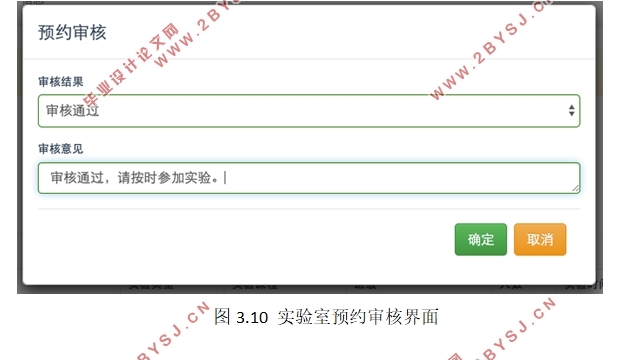
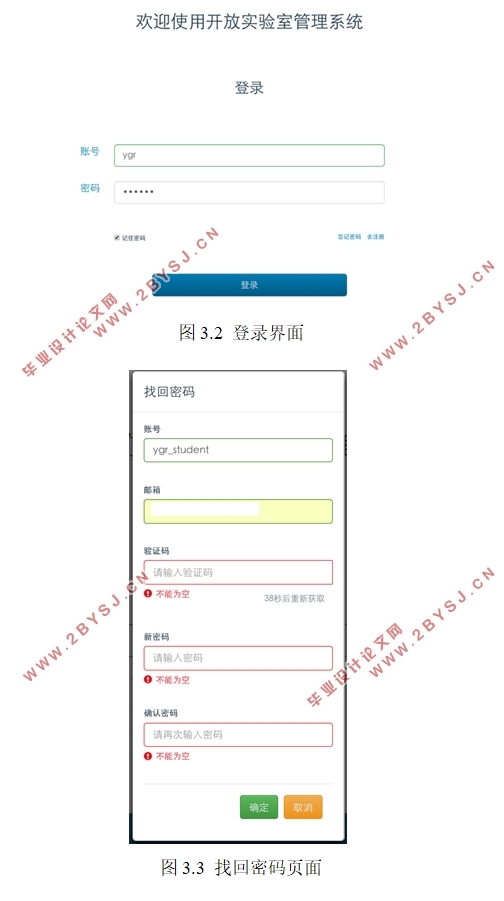
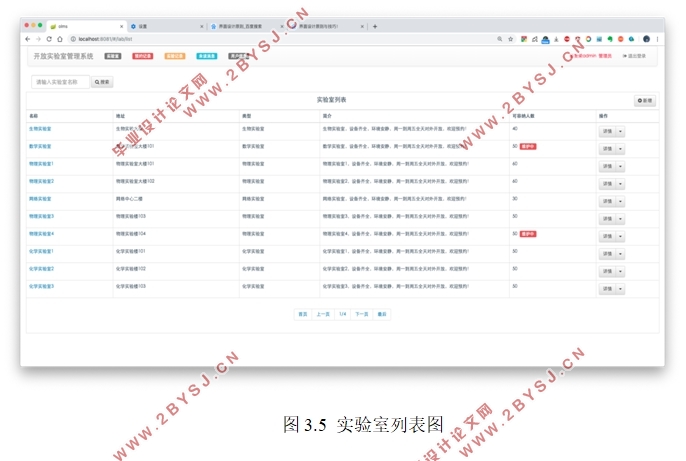
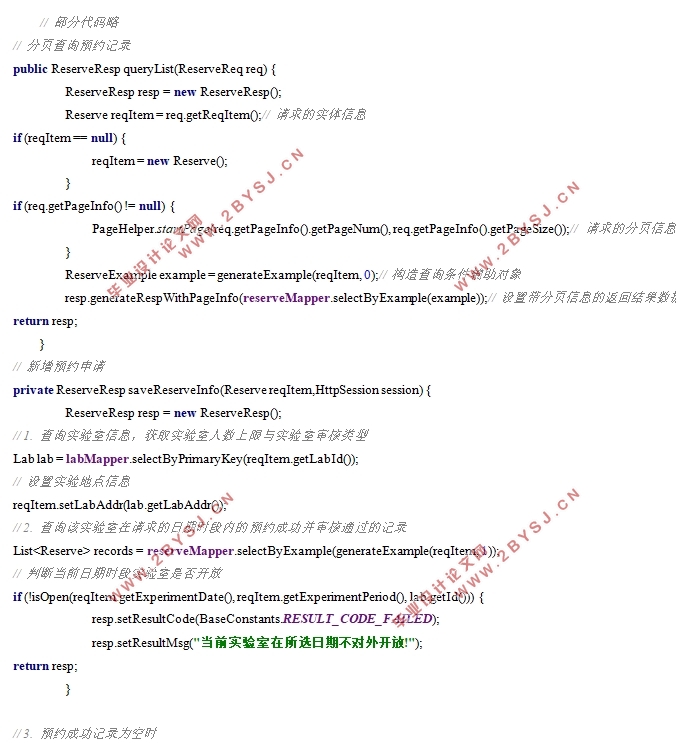


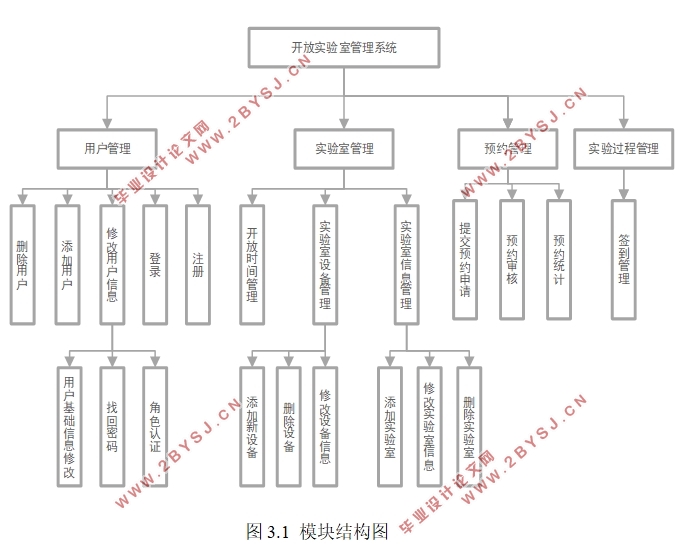
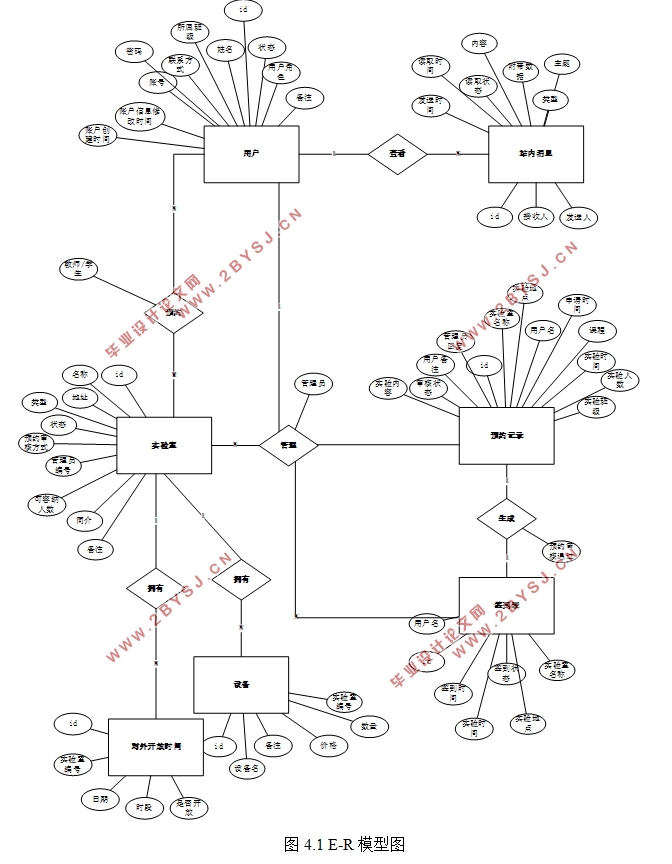
目录
第1章 绪论 1
1.1 背景及意义 1
1.2 国内外研究现状 1
第2章 系统分析 2
2.1 功能需求分析 2
2.2 系统用例 2
2.2.1 用户管理模块系统用例 2
2.2.2 实验室管理模块系统用例 5
2.2.3 预约管理模块系统用例 10
2.2.4 实验过程管理模块系统用例 12
2.3 本章小结 13
第3章 系统设计 14
3.1 功能模块设计 14
3.1.1 用户管理模块 15
3.1.2 实验室管理模块 15
3.1.3 预约管理模块 16
3.1.4 实验过程管理模块 17
3.2 数据库设计 18
3.2.1 数据库概念结构设计 18
3.2.2 数据库逻辑结构设计 20
3.3 界面设计 26
第4章 系统实现 33
4.1 系统框架 33
4.1.1 基础数据部分 34
4.1.2 配置部分 36
4.1.3 逻辑处理部分 36
4.1.4 前端架构 37
4.2功能实现 37
4.2.1 预约管理后台service 38
4.3.2 用户管理后台service 41
4.3.3 前端功能实现 42
第5章 结束语 47
参考文献 48
致谢 49
